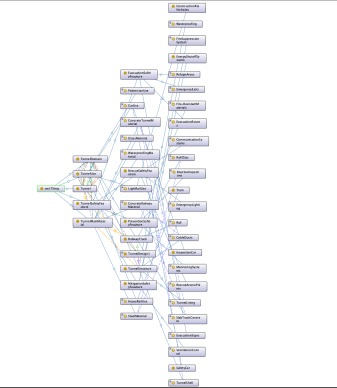Tunnel Number 02
- Ontology
Introduction
The civil engineered system I chose is the Tunnel. One of many engineering structures that serve the purpose of guiding traffic routes under or through obstacles . In rare cases, tunnels or underground routes in German called Unterflurtrassen are also built for the purpose of noise reduction for inhabitants in near range. The principle remains the same, two to the day light open point are connected through an underground structure
Purpose of Ontology
The purpose of my tunnel, from an engineering perspective, is to provide a feasible and efficient solution for traversing a mountainous region where a bypass route would be impractical due to the significant elevation differences. By constructing the tunnel through the mountain, we enable a direct and reliable route for rail transport, reducing travel time and avoiding the challenges posed by steep terrain.
Function of Ontology
The tunnel serves several essential functions, such as ensuring a smooth passage for the railway through difficult topography, while also enhancing safety and reliability for travelers. Its functionality includes providing emergency routes, ventilation shafts, and lighting systems to maintain safe conditions for passengers and workers. Additionally, fire suppression systems are integrated to minimize risk in case of an incident.
Intended End users
The intended end-users could be designers, engineers, and safety planners involved in the design, construction, and maintenance of tunnel systems. The ontology is intended to be used as a knowledge representation tool to support the creation of parametric models, aid in safety analysis, and assist in designing reliable tunnel systems. It helps in visualizing and analyzing the relationships between various components and features of the tunnel, ensuring a comprehensive design approach.
Need of an Ontology
The number of involved experts is high, and they usually do not speak the same technical language. Therefore, We need a support for a a unified model of knowledge. I think this summarizes the importance of a web based platform where geographical and language barriers can be overcome.
Onto Graf of Ontology
Engineering Examples
Use Case 1: Expansion of Emergency Exits An existing tunnel is being upgraded to include additional emergency exits for enhanced safety due to changing external circumstances. The ontology aids in determining the optimal positions for these emergency exits by analyzing the tunnel’s structure and safety features. It also supports the selection of suitable materials that align with safety standards, ensuring that the modifications integrate seamlessly into the existing system. By using the ontology, engineers can systematically address safety requirements and evaluate the compatibility of components, ultimately creating a more robust emergency infrastructure.
Use Case 2: Material Optimization Due to increased safety requirements, an existing tunnel needs structural reinforcement. The ontology facilitates the selection of appropriate reinforcement materials that will ensure durability and compliance with new standards. By evaluating the properties of various materials and their compatibility with the tunnel’s current construction, the ontology helps engineers make informed decisions. This approach not only guarantees that the tunnel meets the new safety demands but also ensures cost-effective material usage, optimizing the overall upgrade process.
Use Case 3: Integration of Ventilation Systems A tunnel lacking sufficient ventilation must be retrofitted to ensure the proper airflow and safety of users. The ontology assists in selecting the appropriate ventilation system by analyzing the tunnel’s current design and environmental requirements. It provides insights into the optimal placement of ventilation shafts and components while considering the tunnel’s existing features. This structured approach helps engineers choose the most effective system, ensuring the integration is efficient and meets both safety and operational standards.
References
- DIN 1076:1999-11. Ingenieurbauwerke im Zuge von Straßen und Wegen – Überwachung und Prüfung. Berlin: Beuth Verlag.
- Hartl, D. J. (2021, 24. Dezember). Lärmschutztunnel für Autobahn, Straße, Bahn. https:// www.stadtgrenze.de/t/tunnel/tunnel-grund.htm, 19.11.2024
- Howard, T.E., McWilliams, J.R. (1984). Tunnels, tunneling . In: Finkl, C. (eds) Applied Geology. Encyclopedia of Earth Sciences Series, vol 3. Springer, Boston, MA. https://doi.org/ 10.1007/0-387-30842-3_70
- Girmscheid, G. (2008). Baubetrieb und Bauverfahren im Tunnelbau. https://doi.org/ 10.1002/9783433600191
- Deutsche Bahn Aktiengesellschaft & Eisenbahn-Bundesamt. (2024). Richtlinie Anforderungen des Sicherheitskonzeptes an den Bau und den Betrieb von Eisenbahntunneln. In Richtlinie Anforderungen Des Sicherheitskonzeptes An den Bau und den Betrieb von Eisenbahntunneln.
- Cristani, M., Majorana, C. & Salomoni, V. (2009). Tunnels in an Ontological Perspective. Civil-comp Proceedings. https://doi.org/10.4203/ccp.82.2
- Kolymbas, D. (2018). Geotechnik. In Springer eBooks. https://doi.org/ 10.1007/978-3-662-58472-9
